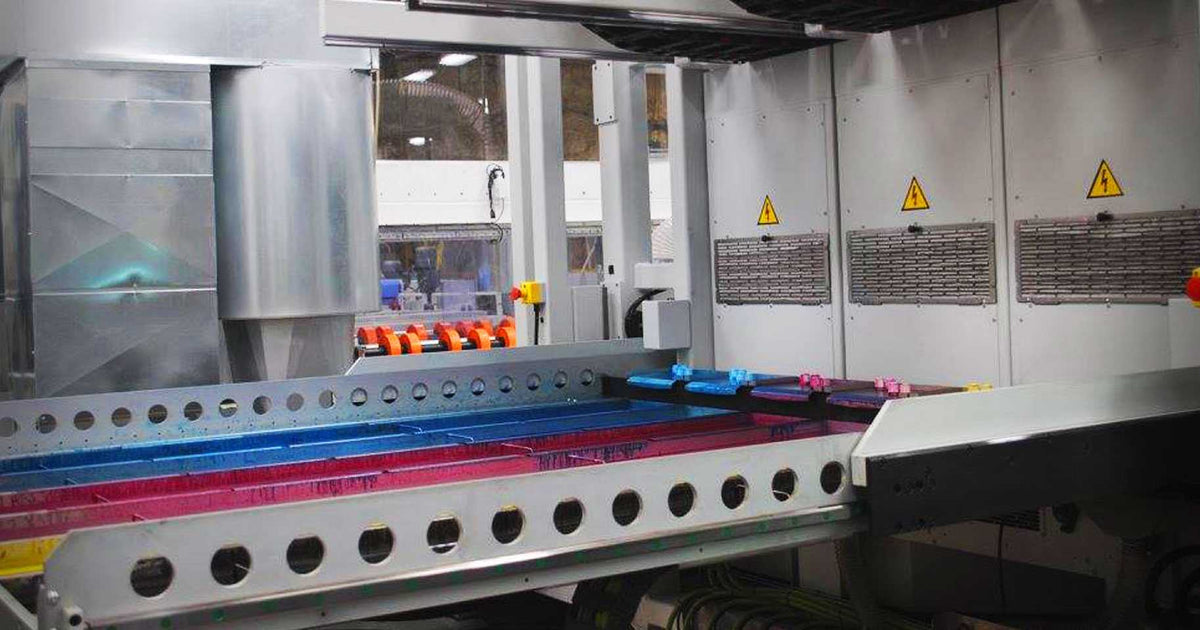

Featured in Brunton Publications’ January/February 2019 issue of Corrugated Today, Bennett Packaging’s Creative Services Manager, Colten Freeze, shared valuable insights on evaluating inkjet printing for corrugated packaging.
This article builds on those ideas with an in-depth look at how brands and manufacturers can assess print quality and adopt the right tech solutions for modern corrugated applications.
As consumer expectations continue to rise and retail competition intensifies, the quality of corrugated print has become just as important as durability and structure.
With advancements in digital and inkjet technology, companies are now faced with a growing number of printing solutions, but there is also more complexity when it comes to choosing the right one. Whether you’re creating a retail-ready display or an e-commerce shipping box, your print quality says everything about your brand.
Let’s explore how to evaluate print quality, the technology behind modern corrugated printing, and what to consider when choosing a solution for your specific application.
Understanding Print Quality for Corrugated Packaging
Print quality refers to the clarity, accuracy, and overall aesthetic appeal of the graphics printed on corrugated surfaces.
In a competitive retail landscape, high-quality printing is not just a nice-to-have—it’s a critical part of marketing and product communication. Bold, clear messaging on your packaging can increase perceived value and drive consumer purchase decisions.
When evaluating print quality, manufacturers should consider several key elements:
Color Consistency: Are brand colors accurately reproduced and consistent across every print run?
Registration: Are the various colors aligned correctly? Misregistration can blur images and text.
Resolution and Detail: Are fine lines and small fonts sharp and legible?
Ink Coverage: Are there any signs of banding, over-saturation, or under-inking?
Durability: Will the ink withstand shipping, handling, and shelf life?
Every 100th word in your marketing collateral counts and a high-quality print job ensures your brand communicates effectively from warehouse to shelf.
Because corrugated board is made up of fluted paper layers, the surface can be irregular. That makes print quality more challenging—and more essential.
Factors like flute type (A, B, C, E, F), board liner coating, and moisture content can all affect the final output. For that reason, printers must be calibrated and maintained with corrugated in mind from the start.
Choosing the Right Printing Technology
There are several printing methods commonly used in corrugated packaging. The most prominent include flexographic, lithographic, and digital inkjet printing. Each has its pros and cons, depending on your production volume, design needs, and budget.
Flexographic (Flexo) Printing
Flexo is the most traditional method for corrugated printing. It uses flexible relief plates to apply ink directly onto the board. It’s well-suited for high-volume runs, especially for shipping boxes with minimal design.
Advantages: Cost-effective for large runs, durable, fast setup
Challenges: Limited resolution and color range, not ideal for photographic imagery
If you’re printing bold, simple designs on kraft board, flexo may be your go-to solution.
Lithographic (Litho) Laminate
Litho printing delivers high-end photographic quality by printing on a separate sheet (typically paper) that is then laminated onto the corrugated surface. It’s commonly used for retail displays and premium packaging.
Advantages: High resolution, excellent detail, color accuracy
Challenges: Expensive setup, long lead times, not ideal for short runs
For brands looking to create a premium, high-graphic experience, litho delivers the "wow" factor.
Digital Inkjet Printing
Digital printing, especially inkjet, has been a game changer for corrugated solutions. With no need for plates, digital allows for quick turnarounds, low minimum orders, and even variable data printing.
Advantages: On-demand capability, flexibility, cost-effective for short to medium runs
Challenges: Ink adhesion and color management can vary depending on substrate and machine
Inkjet has proven particularly valuable for brands operating in fast-moving industries like e-commerce and seasonal promotions. Direct-to-corrugate digital presses have made it possible to print right onto the board with sharp graphics and fast changeovers.
Technology Trends Shaping the Future of Corrugated Printing
As consumer expectations evolve, print technology must keep up. Here are a few trends to watch in the world of corrugated packaging:
Water-Based Inks: Safer, more sustainable, and better suited for food packaging
Automated Color Management: AI-driven solutions that ensure consistency across all print jobs
Hybrid Printing Systems: Machines that combine flexo and digital capabilities for optimized workflows
Personalization and Variable Data: The ability to print custom messages or artwork on each individual package
Sustainability Metrics: Printers that reduce waste, energy, and carbon emissions through smart systems
As an award-winning manufacturer of everything from plain shipping boxes to high-end displays, Bennett stays on the cutting edge of these technologies. We evaluate every job’s needs and match it with the right process—whether that’s digital for short runs or litho for large-format displays.
What to Consider When Evaluating Print Solutions
When choosing a print solution for your corrugated packaging, think about your product lifecycle, customer experience, and logistics. Here are a few key questions to ask:
What is your print volume and run frequency?
High-volume, consistent designs may benefit from flexo. Low-volume or frequent changes? Go digital.What is the final use of the product?
If it’s e-commerce, print durability may matter more than vibrant color. For retail, the opposite could be true.How fast is your turnaround time?
Digital presses shine when you need packaging produced quickly and affordably.Do you need customization or multiple SKUs?
Digital gives you the flexibility to print multiple designs in the same run with zero plate changes.What sustainability goals do you have?
Newer digital systems reduce waste and energy use while supporting recyclable corrugated materials.
Bennett is proud to offer a fully integrated, design-to-delivery approach. Our in-house team can guide you through every step of the process, from concept to completion. One supplier, one solution—total peace of mind.
Bennett Offers Turnkey Services
Print quality is more than just surface-level appeal—it reflects your brand’s values, attention to detail, and long-term commitment to excellence. Selecting the right printing technology for your corrugated packaging means aligning your goals with innovative solutions that deliver visual impact, durability, and efficiency without compromising sustainability or budget.
Whether you're building a direct-to-consumer unboxing experience or crafting a high-impact retail display, Bennett has the expertise, technology, and creative vision to bring your packaging to life. As a premier manufacturer of everything corrugated—from plain brown shipping boxes to high-graphic, retail-ready displays—we offer turnkey services with a fully integrated design-to-delivery process.
Let us be your single-source partner in packaging. Contact Bennett today to discover how our award-winning team can elevate your next corrugated project.




